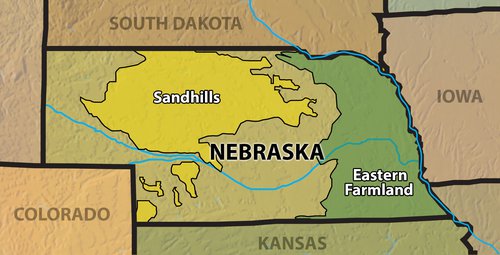
Initiative 300, the anti-corporate farming amendment, passed in 1982. The farm crisis that had begun during the late 1970s deepened in the ’80s. The prices being bid for agricultural land dropped. Opponents of I-300 were quick to argue this was partially because corporations were no longer allowed to bid for farmland in Nebraska. Supporters of Initiative 300 responded that the amendment was doing exactly what it was intended to do — keep corporations from snapping up Nebraska farm and ranch land at fire sale prices.
So, as soon as the amendment was passed, there were groups who lobbied to repeal it. This was an emotional battle.

The Nebraska Farmers Union, the National Farmers Organization, WIFE (Women Involved in Farm Economics), the American Agriculture Movement, the Nebraska Grange, the Center for Rural Affairs, the Nebraska Catholic Conference, and the board of directors of the Nebraska Conference of the United Church of Christ all indicated their unwavering support of Initiative 300.
Opponents of Initiative 300 included the Nebraska Farm Bureau and the Nebraska Livestock Feeders Association. They argued for a free enterprise system unfettered by government regulations. Keeping corporations out of the land market hurt land prices. Large ranches that were for sale were unable to find buyers, since individual buyers could not afford to purchase any more land. By taking non-farm corporations out of the market, you eliminated buyers with money to spend who could have added some stability to the land market.
Supporters of I-300 countered that a more significant factor affecting the decline of land prices was the extent to which land was formerly overvalued — they said corporations had bid land valued higher than the income the land could produce. They added that corporations could bid high prices because they got special tax shelters.
Investors in corporations also had "limited liability" — if a corporation goes bankrupt, the owners can’t lose any more money than they have invested in the company. Their personal assets are safe from creditors. Corporations are also taxed at lower tax rates than individuals and can pass tax benefits on to investors or stockholders in high tax brackets. Corporations were also able to speed up investment tax credits and depreciate equipment at an accelerated rate, which would lessen the cost of their investments.

Geographic location played a role in which farmers opposed Initiative 300 and those who supported it. Corporate buyers prefered to buy large tracts of inexpensive range land (like the Sandhills area) that had irrigation potential for growing crops and/or sandy soil conditions that were suitable for large cattle feedlots. As one Otoe County Farm Bureau member put it, "Corporations don’t want our old tiger clay." Corporate investors seemed less likely to buy land in eastern Nebraska since it had poor irrigation potential or had already been developed.
Proponents of Initiative 300 responded that states without restrictions on corporate farm ownership were also experiencing severe land price declines. For example, Ohio, which did not restrict corporate purchases of farmland, had seen land values drop 28% since 1981, compared with Nebraska’s decline of about 25%.
Neil Oxton, president of the Nebraska Farmers Union, argued in 1984 that current land market conditions related more to the depressed agricultural economy than to the presence of Initiative 300. He said that a good indicator that the economy was the primarily culprit was the fact that farmers themselves weren’t in the land market.
Other supports of Initiative 300 argued that low prices for farm products like corn was the primary reason land prices were low, not because of the passage of Initiative 300. For example, they said the primary factor that determined the local price of corn was transportation costs to get it to export markets. They felt poor access to the export markets would continue to be the dominant factor in the local corn market in Nebraska. The importance of the export market became painfully clear to the farmers when President Carter placed an embargo on grain shipment to the Soviet Union in 1980 in protest of their invasion of Afghanistan. The American farmers lost an important market and found it very difficult to recapture the Soviet market as other countries like Australia and Canada moved in to take their place. The conclusion reached by supporters of Initiative 300 was that if transportation costs were reduced and foreign markets were opened to American farm products, land prices would go back up.
Supporters of I-300 were also concerned that some Nebraska newspapers were biased in their news reporting, only presenting the views of those who supported repeal of Initiative 300. The Center for Rural Affairs was a grant-supported research and advocacy group in Walthill, Nebraska that was a key supporter of I-300, viewed the Omaha World Herald as the chief culprit.
Information can sometimes come so rapidly and in such volume that a farmer can be overwhelmed and become bogged down. That’s where computer technology can play a role in the farming operation. No other machine has ever come close to the computer’s ability to store, retrieve, and sort data. The computer could very well have as much potential as any machine has ever brought to the farming operation.